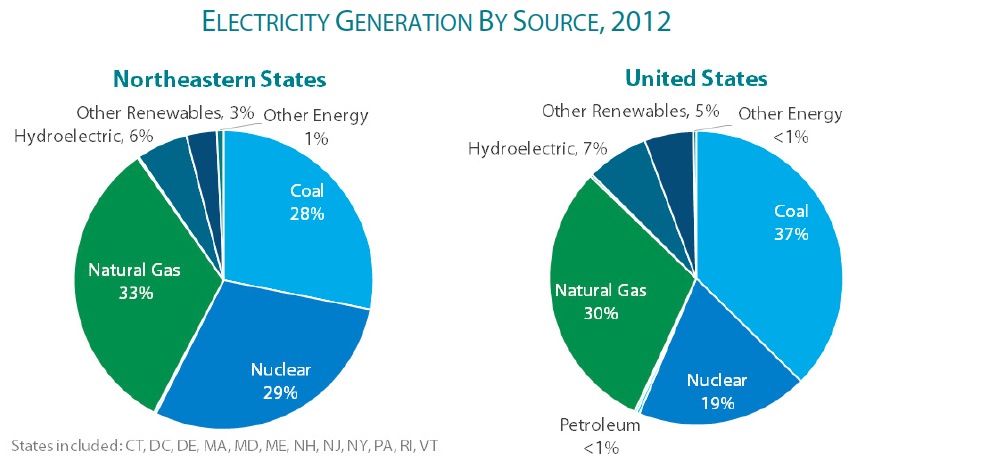AMERICAN COUNCIL ON RENEWABLE ENERGY
With high electricity prices, a reliance on imported energy, and ongoing retirements of fossil fuel power plants, the Northeast has a strong incentive to develop local, renewable sources of energy. Aided by a well-established, supportive portfolio of policies in nearly every Northeastern state, the region ranks second in the nation for both solar power capacity and biomass power capacity. However, renewable energy capacity overall is lower than in the other regions profiled by ACORE’s Renewable Energy in the 50 States report, with fewer large-scale renewable energy facilities like wind farms.
An array of policies and incentive programs, including feed-in tariffs, renewable energy credits (RECs), green banks, and rebates, support the development of renewable power, heat, and fuels in the Northeast. A cooperative effort among nine states in the region, the Regional Greenhouse Gas Initiative (RGGI) aims to reduce regional greenhouse gas emissions and spur investment in renewable energy and energy efficiency. Importantly, New York’s emergent $1 billion Green Bank relies in part on RGGI funding revenues. In addition, eleven of the twelve states1 profiled in this report have binding renewable portfolio standards (RPS) to support continued market growth. Not to be overlooked, the twelfth state, Vermont, drives demand for renewables via a “feed-in tariff”-like standard contract program – the first statewide program of its kind in the country – and through a renewable portfolio goal. Nevertheless, a wind moratorium in Connecticut and recent cutbacks to state incentives in other states threaten to prevent the region from meeting its full renewable energy potential.
Many Northeastern states have set targets for solar energy generation, which, coupled with financial incentives, are largely responsible for driving more solar power capacity in the Northeast than in the Midwest or the Southeast. In fact, ISO New England, the regional transmission organization serving six Northeastern states, anticipates distributed generation installations within its territory to increase from 250 MW in 2012 to 2 GW by the end of 2021, with generation forecast to be mostly solar power.
The Northeast’s wind power market has grown more slowly than other regions’, but this fact could change soon. Coastal states in the region have identified immense offshore wind power potential, and developers are in the advanced stages of planning what would be the first offshore wind projects in the country. In August 2013, the U.S. Department of the Interior held the nation’s first offshore wind lease sale off the coast of Rhode Island and Massachusetts, the scale of which could support enough turbines to power one million homes.To reduce reliance on expensive heating oil, some states, such as New Hampshire, have set goals for renewable thermal energy use. With the availability of wood waste from the forestry sector, homes in New England use wood for space heating, water heating, and cooking at nearly twice the national rate,4 and growth in this sector is expected to continue.
Other renewable energy technologies also help to diversify the Northeast’s energy portfolio. Most of the states in the region, especially New York, Massachusetts, and Maine, are major producers of biomass and waste energy, using a number of available feedstocks like municipal solid waste, wood, and landfill gas. While renewable liquid transportation fuel production is not as prevalent as in other regions, Pennsylvania, New York, and a few other states produce biodiesel and ethanol to reduce their reliance on petroleum. Hydropower has long been a major player in the Northeast’s power market, imported to the region from Canada and produced at a large scale in Maine, New York, and other states.
Renewable energy is steadily becoming more cost competitive in the Northeast. Three large utilities in Massachusetts recently signed long-term contracts to purchase renewable energy at less than $0.08 per kilowatt hour, below the cost of most conventional sources. If the contracts are approved by state regulators, they would save customers between $0.75 and $1.00 a month.5 Likewise, if it doubles the amount of wind power it plans to build, the PJM Interconnection could actually reduce wholesale energy market prices and save nearly $7 million per year in the mid-2020s.
Companies and institutions in the Northeast specialize in the research and innovation of renewable energy. Maine is home to the country’s first tidal energy device to generate electricity for the power grid as well as its first working offshore wind turbine. A number of cleantech companies in Massachusetts are on the cutting edge of technology development, with about $229.1 million in venture capital and private equity investment raised for renewable energy in 2012. New York has upped the regional ante with the formation of a Green Bank, designed to bring lower-cost capital into the renewable energy space. In addition, damage caused by Hurricane Sandy has motivated energy infrastructure development in the region; the New Jersey Transit System is now working with the U.S. Department of Energy to create one of the largest civilian microgrids, which would be able to operate when the central grid is compromised.
With RGGI, strong RPS programs, distributed generation incentives, innovative institutions, and efforts underway to build larger-scale renewable energy facilities, the future of renewable energy in the Northeast is bright.
Download full version (PDF): Renewable Energy in the 50 States – Northeastern Region
About the American Council on Renewable Energy
www.acore.org
ACORE, a 501(c)(3) non-profit membership organization, is dedicated to building a secure and prosperous America with clean, renewable energy. ACORE provides a common educational platform for a wide range of interests in the renewable energy community, focusing on technology, finance and policy. We convene thought leadership forums and create energy industry partnerships to communicate the economic, security and environmental benefits of renewable energy.
Tags: ACORE, American Council on Renewable Energy, Northeast, Wind Power







 RSS Feed
RSS Feed